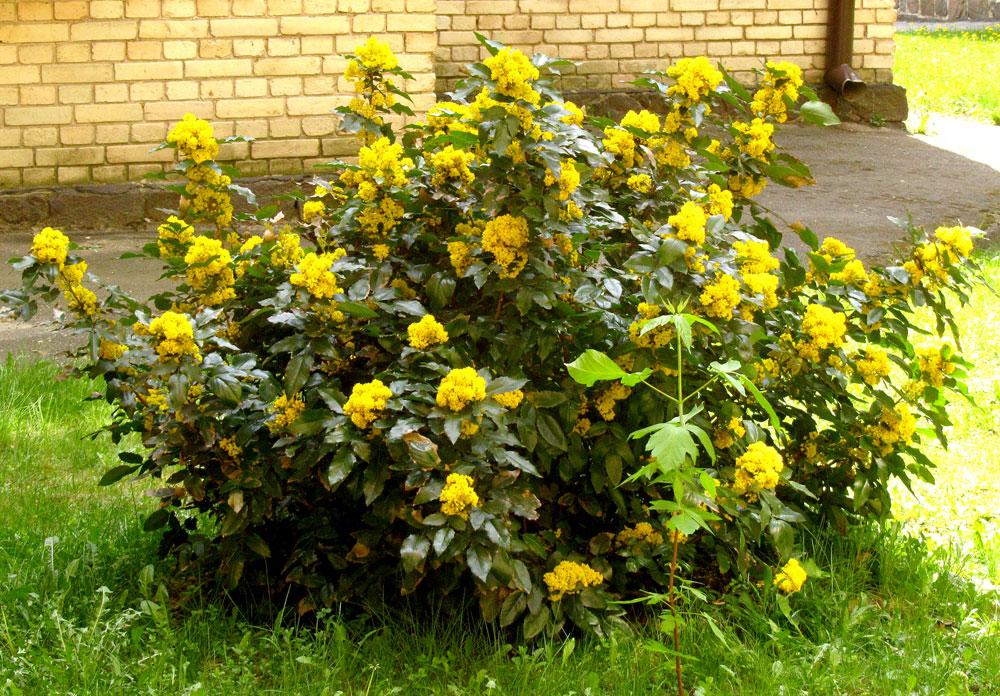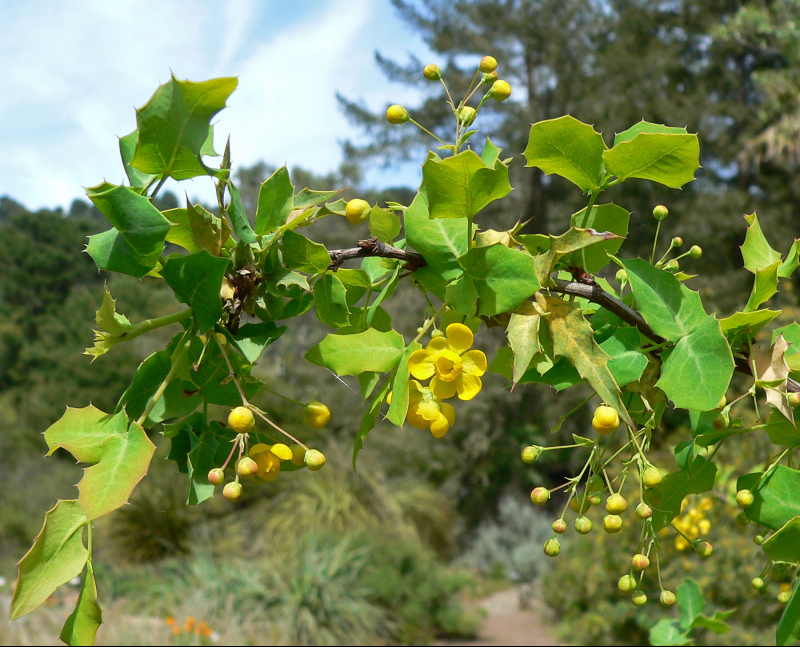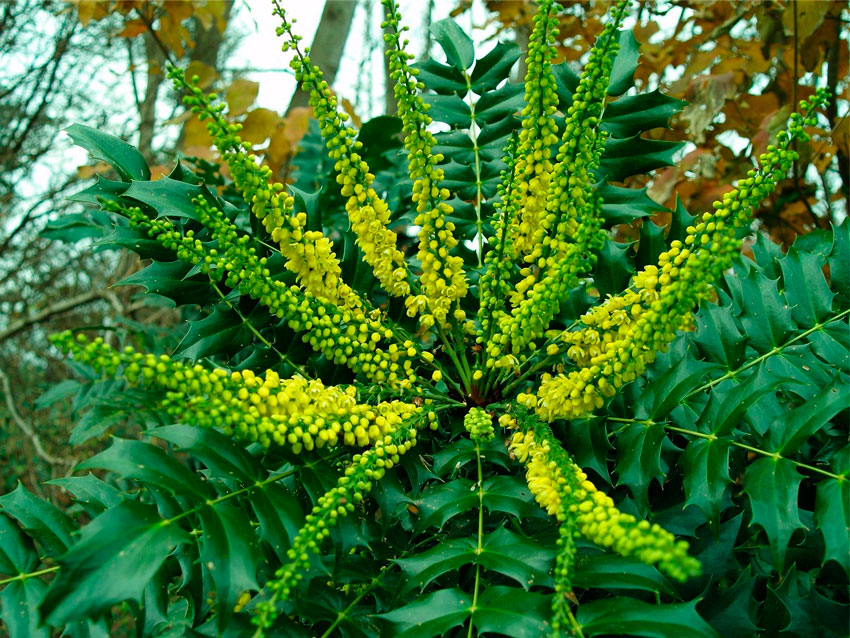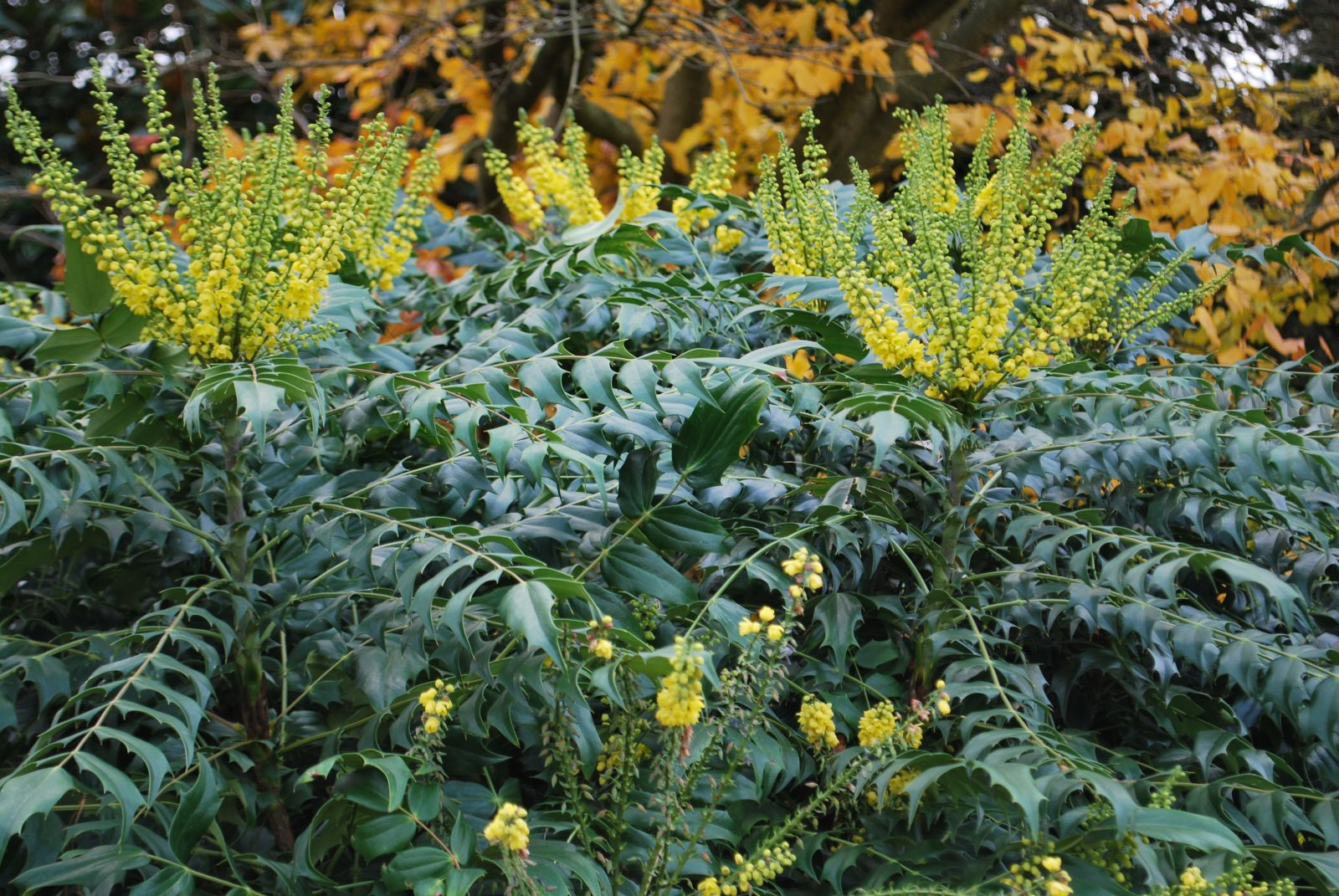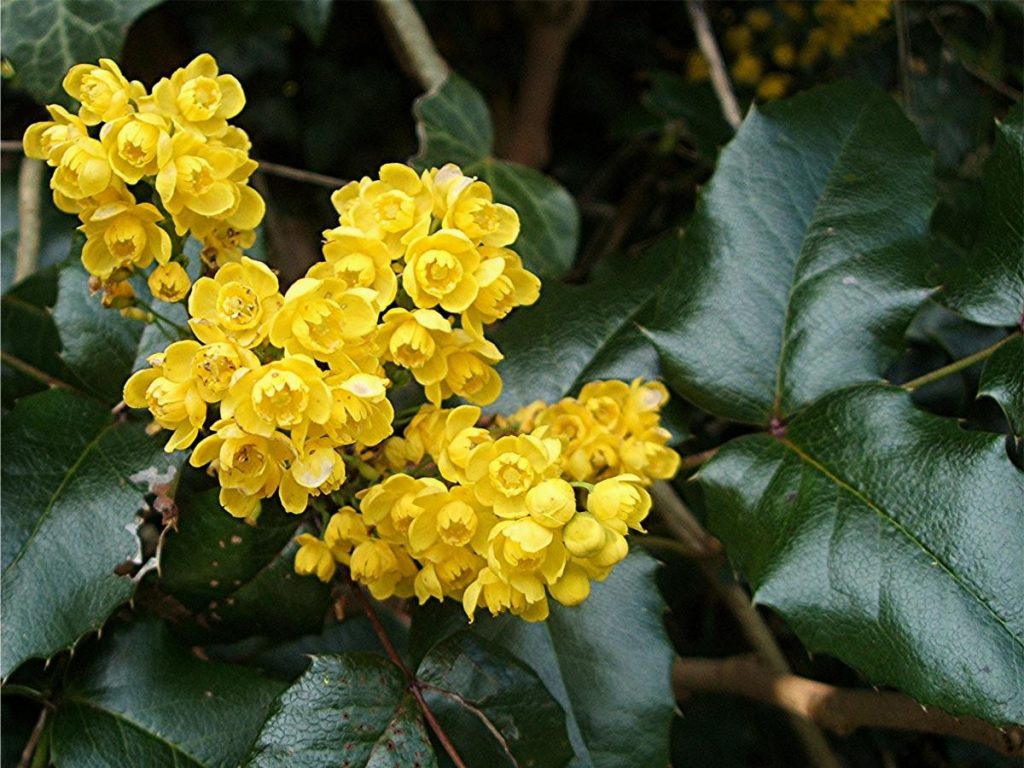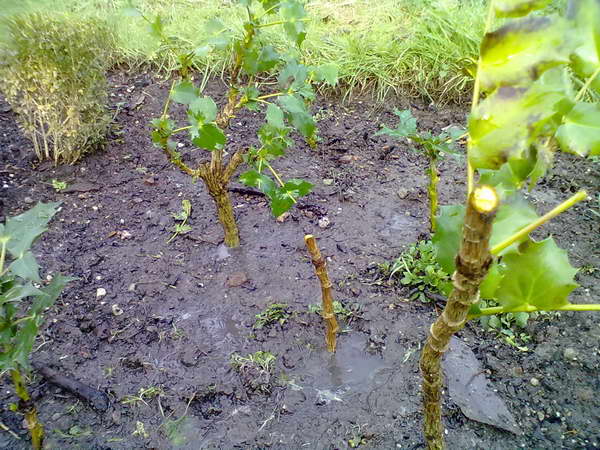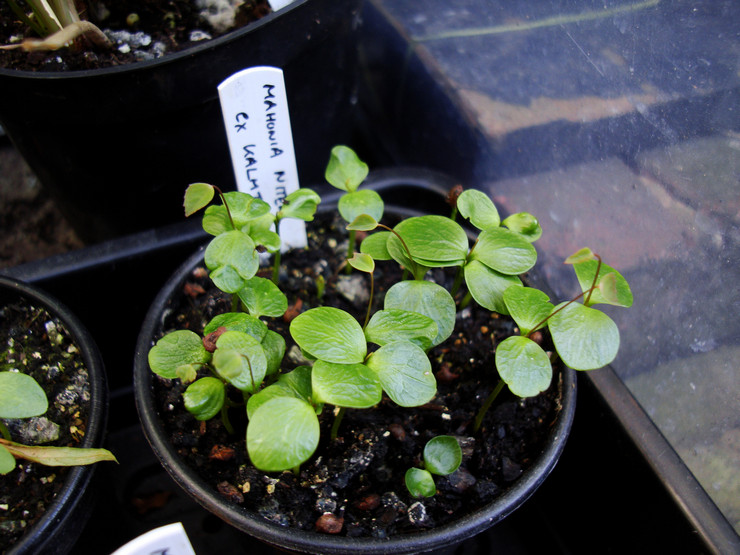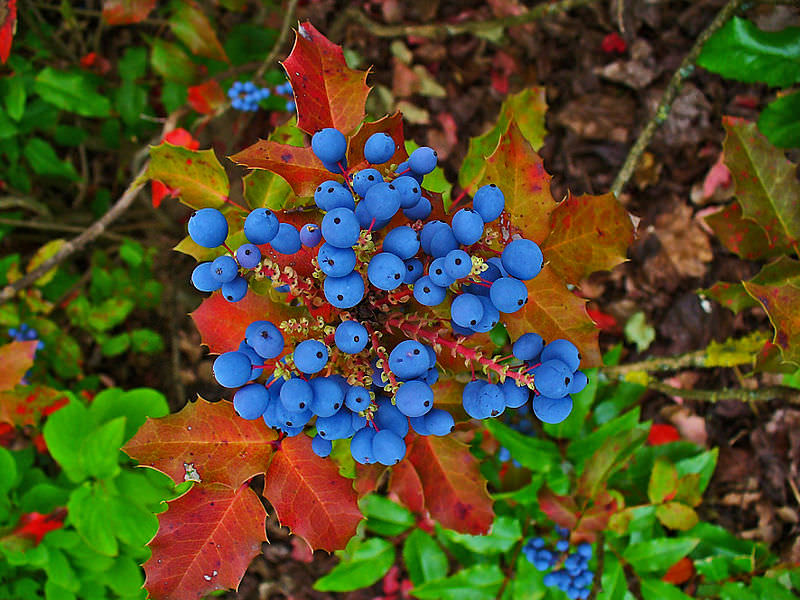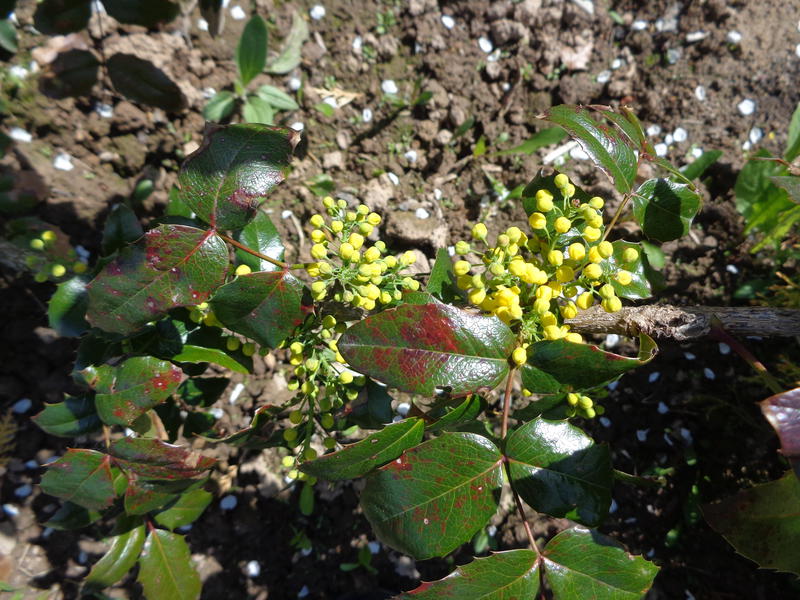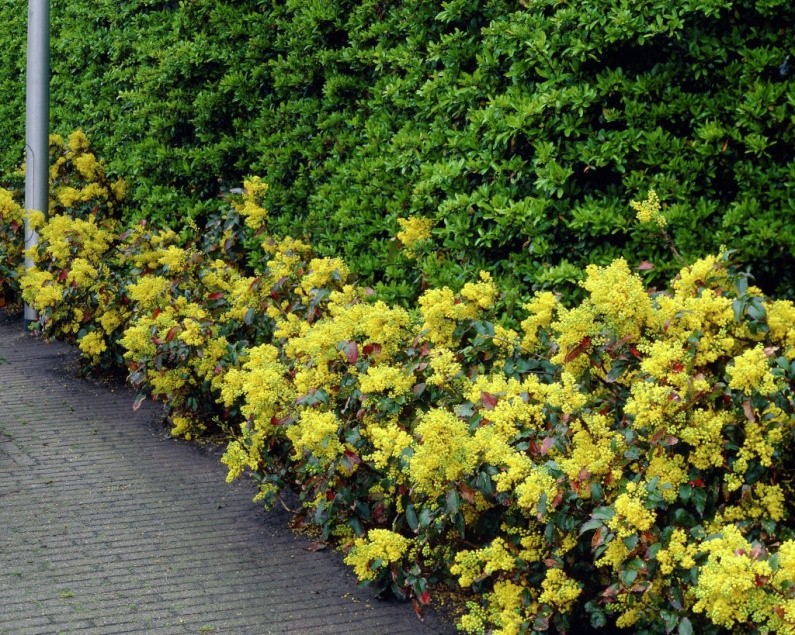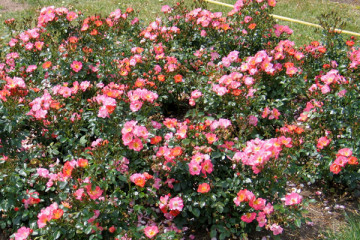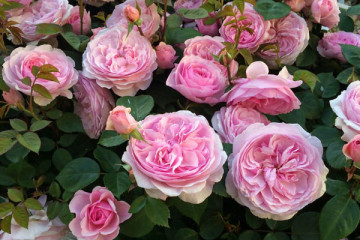Mahonia aquifolium - all about shrub breeding
Content:
Mahonia holly is an evergreen shrub that can survive even in severe frosts. It is used in medicine, food preparation, landscape decoration and cosmetics.
What does Mahonia holly look like?
Mahonia holly belongs to the Barberry family - these are dicotyledonous flowering plants that are included in the order Buttercup. They include more than 40 species that are common in America and Asia. Popular varieties such as Apollo and Atropurpurea were developed by Dutch gardeners in the 20th century.
Description of appearance: Mahonia plant looks like a shrub without thorns with shiny alternate leaves. Small flowers are yellow in color and are located in large inflorescences. The leaves are framed at the edges with denticles. The fruits are blue. It is rare to find a Mahonia bush with red or white berries. A shrub grows up to 1.5 meters. Leaves acquire a reddish-bronze color in autumn.
What are the varieties of Mahonia
Mahonia is crossed with plants from the genus barberry. Among the popular decorative forms, the following are distinguished:
- Walnut (f. Juglandifolia). Looks like holly mahonia. The difference is in the foliage. The plant has 7 small leaves on each branch. Leaves are dense with a red petiole.
- Graceful (f. Gracilis). Differs from typical species in longer leaves.
- Golden (f. Aurea). The foliage of such Mahonia has a golden color.
- Variegated (f. Variegata). The leaves contain a patchy color of green and gold.
Species of Mahonia holly occurring in nature
Some varieties of Mahonia have their own characteristics of cultivation and care. Below are some of the most famous species in horticulture.
Magonia creeping (Mahonia repens)
The shrub is 20 to 50 cm high. The leaves are large green. Blooms from late spring to early autumn. The fruits ripen by the end of the summer season. Mahonia flower has a lemon color. The plant survives even with sudden changes in temperature.
Mahonia japonica
It is widely distributed in Japan and other regions with a tropical climate. The aroma is reminiscent of lily of the valley flowers. The shrub grows up to 150 cm. Inflorescences are directed in different directions. The flowers are bright yellow.
Mahonia Winter sun
The plant reaches 200 cm high. Blooms in winter. It resembles Japanese in appearance.
Mahonia Fremontii
The shrub grows up to 300 cm. The young plant has gray-blue leaves. The berries are red.
Mahonia bracts Soft Caress (Mahonia eurybracteata Soft Caress)
The plant is native to China. The leaves are narrow. Flowering takes place in summer.The bush is grown in special containers and in greenhouses.
Mahonia Neubertii
The height of the plant does not exceed 110 cm. The leaves are ovoid.
The varieties most popular with gardeners
The varieties presented below are winter-hardy and unpretentious in care, which attracts the attention of gardeners.
- Magonia Apollo (Apollo). The bush grows from 50 to 100 cm. Leaves 25 cm long have a sharp-toothed edge and consist of 7 leaf plates. They are green in summer and brown in autumn. The flowers are colored lemon. The dark blue berries contain a waxy coating on the skin.
- Magonia atropurpurea (Autropurpurea). The height of the bush reaches 65 cm. The leaves are dark green. They do not exceed 30 cm in length. The flowers are bright yellow.
- Magonia Smaragd. A distinctive feature is the shiny emerald-colored leaves with a clear pattern of veins.
How Magonia holly reproduces
Mahonia is cross-pollinated. A single bush has no harvest. If a gardener grows a shrub as an ornamental and berry crop, then he needs to plant at least 2 plants side by side. There are several ways to multiply Mahonia.
Cuttings
For propagation of Mahonia holly cuttings, it is necessary to cut branches with 6 buds in early spring. They are planted in the shade. The soil is moistened daily. Before the first winter, the cuttings are spud and covered with straw. In the next season, they will be landing on a permanent place.
Dividing the bush
In early spring, when the juice has not yet begun to move in the trunk and branches, the bush is divided into several shoots. The cuttings are planted in a permanent place in the usual way.
Layers
In the spring, one of the branches of the plant is lowered to the ground and fixed with a metal bracket. The leaves are preliminarily removed, and the stem lowered down is sprinkled with earth. No additional care is required. In the spring, the seedling that we managed to grow is transplanted to a new location.
Growing from seeds
This is a laborious way. In autumn, seeds are sown in holes 2 cm deep. They can also be planted in spring after stratification at temperatures from 0 to +5 degrees. Seedlings are left in the shade. In the fall, it is thinned out and seated in separate boxes. After 1.5 years, the seedlings are planted in open ground. Mahonia will begin to multiply by layering in 4 years.
Features of care in the garden
Care and cultivation of Mahonia holly includes daily watering, feeding, treating the bush from pests, as well as pruning. The plant needs a lot of moisture, gardeners water the near-trunk circle and irrigate the upper branches. This should be done in the evening. Adult shrubs do not need to be watered if the weather is not dry. In hot summer, plants should be irrigated 2 times every 14 days.
Shrubs are fed twice in 12 months: the first in May, and the second at the end of February. Mineral complexes are used as it. 150 g of fertilizer is required per square meter. When preparing shrubs in the open field for winter, sprinkle the soil with compost or humus. Their layer should be at least 6 cm.
It will not work to take care of Mahonia without a transplant. It is carried out throughout the growing season. The bush should not be transplanted only in the fall. He will not have time to take root and will die with the onset of cold weather. Also, care includes pruning sick, dry and frozen branches over the winter. They do it at the end of February. To prevent the bushes from thinning out and staying low, pruning is done in October after the plant stops blooming.
Young bushes are covered with spruce branches before winter.Adult shrubs should be subjected to the same manipulations only if frost is promised. The plant survives peacefully under the snow. Mahonia prefers loose, fertile soil. The best option for her is soil, consisting of humus, sand and turf.
When and how it blooms
Flowering lasts from April to May. Mahonia refers to the order of dicotyledonous flowering plants. This is a class in which the flower acts as a reproductive organ, and the seed embryo has two cotyledons located on the sides. The flowers consist of 9 sepals and 6 lemon-colored petals, collected in panicle inflorescences. The leaves are arranged in two circles.
The anthers open in a flap manner, from bottom to top. In some varieties, there are two circles of nectaries between the sepals and stamens. The upper ovary is one and consists of one carpel. The ovules are numerous, in some varieties - single, located along the ventral suture of the ovary.
The fruits are blue berries. They reach 1 cm in length and 0.7 cm in width. There is a fine fluff on top of the berries. One fruit contains 2-8 seeds.
Possible growing problems
Mahonia is resistant to pests and various diseases. However, with improper care, traces of rust, powdery mildew, and spotting are noticeable on the plant. Below is a list of diseases, as well as recommendations for their treatment.
- Spotting. It manifests itself in the form of crimson spots of various sizes located on the leaves of the plant. They can form if the plant is planted in an area with polluted air and due to lack of nutrients. Treat spotting by spraying with products containing copper or polycarbacin.
- Powdery mildew. It is a fungal disease that affects the leaves and fruits of the shrub. It looks like a white mottled bloom. The bush is treated in the summer, once every 2 weeks by spraying it with topsin-M or caratan. As a preventive measure, shrubs are fertilized with mixtures that include a large amount of potassium and phosphorus.
- Rust. The disease is caused by a rust fungus. It looks like orange spots on the leaves. Soon, these pustules crumble. When you touch them, rusty sand remains on your hands - mushroom spores. Rust reduces frost resistance, worsens productivity. Its development is facilitated by an excess of nitrogen fertilizers. Cynab and sulfur-containing products help get rid of rust.
- Phylostictosis. This disease is a spreading infection. The affected areas turn brown or brown. Leaves die off over time, and the intensity of flowering worsens. The disease is spread by wind and raindrops. The fungus gradually begins to penetrate the stem as well as the root system of the plant. To get rid of it, you must first remove the affected and fallen leaves, and then treat the bush with a fungicide.
The main indicators that the gardener is not properly caring for the bush are the formation of spots, as well as other lesions, excessive falling of fruits, leaves and buds. If the plant begins to wither, then it must be transplanted to a new place, cut off all damaged areas, water, and then add fertilizers to the soil. If necessary, the bush is sprayed with a "medicinal" agent.
Among pests, Mahonia, like barberry, attracts the attention of the following individuals:
- Aphid. It is a small yellow or red insect that lives under the leaves of the plant. Aphids slowly eat the bush. "Aliot" or "Kinmiks" will not help to get rid of. Also, the product is made independently by mixing a spoonful of tobacco, soap and 200 ml of water.
- Sawfly. It looks like a caterpillar with a black head and sixteen legs. The insect feeds on shoots and foliage. The drug "DNOC" will help to get rid of it.
- Fruit moth. This insect eats the fruits of Mahonia and other trees in the garden.It is a gray-brown moth larva that leaves its offspring inside foliage or fruit. The hatched insects begin to rapidly eat the plant. Get rid of it with insecticides.
In order for all means to work as efficiently as possible, all affected leaves are cut and burned before spraying. Water the bush before buds appear.
Use in landscape design
Magonia is one of the ornamental plants. Its fruits and flowers have a bright color, which fits perfectly into the landscape design. Shrubs are often planted to create a decorative forest belt. The average number of rows of bushes in it is 3-5. Despite the fact that such a forest belt is necessary only for a beautiful view, it also performs practical functions. Rows of Mahonia bushes protect from the wind and block out noise.
Isolated bushes among the lawn look interesting, but additional care is needed for such plants. Over time, their root collar begins to undermine, which leads to death. To avoid such a situation, a well is formed around the trunk. It is designed in the form of a small fence or a bench. The shrubbery is dug around to create a slope.
Magonia is used to create hedges. To control the growth of its root system, at the stage of planting the hedge, slate or metal plates are dug in on the sides. To create the desired contour, after flowering is completed, the excess branches are cut off. Shearing is also done in the spring to get rid of frozen branches. In case of severe frosts, burlap is thrown over the hedge. In addition, landscape designers create beautiful combinations of shrubs with undersized trees, bulbous flowers and roses.
Mahonia contains many tannins, ascorbic acid and alkaloids. The use of its extract in medicine, allows you to fight diseases of the vascular system, intestinal tract, as well as a decrease in blood sugar. With proper care, a shrub may not wither for many years. After pruning, the plant recovers quickly. Mahonia is unpretentious in care and patient with temperature changes.
